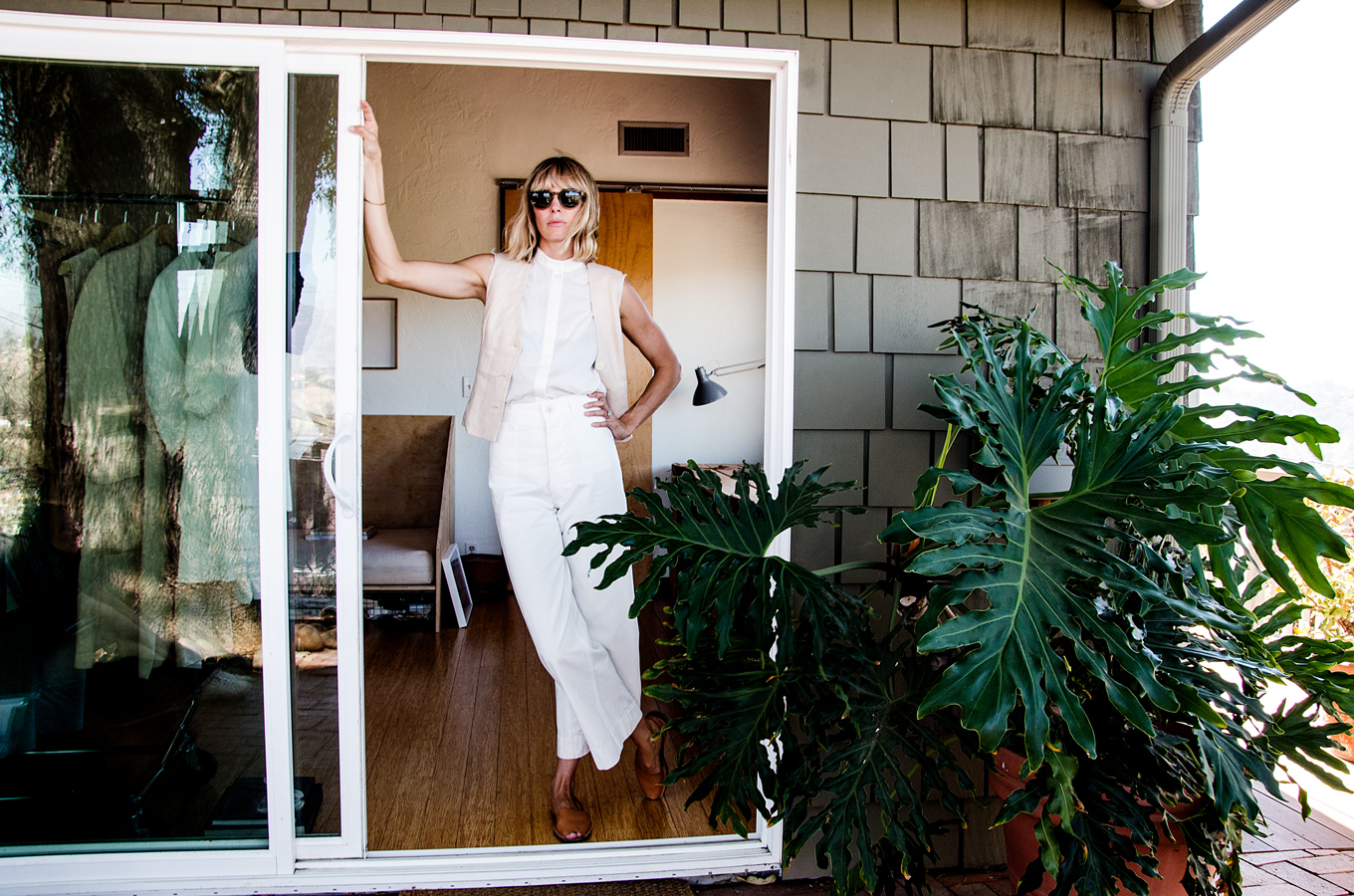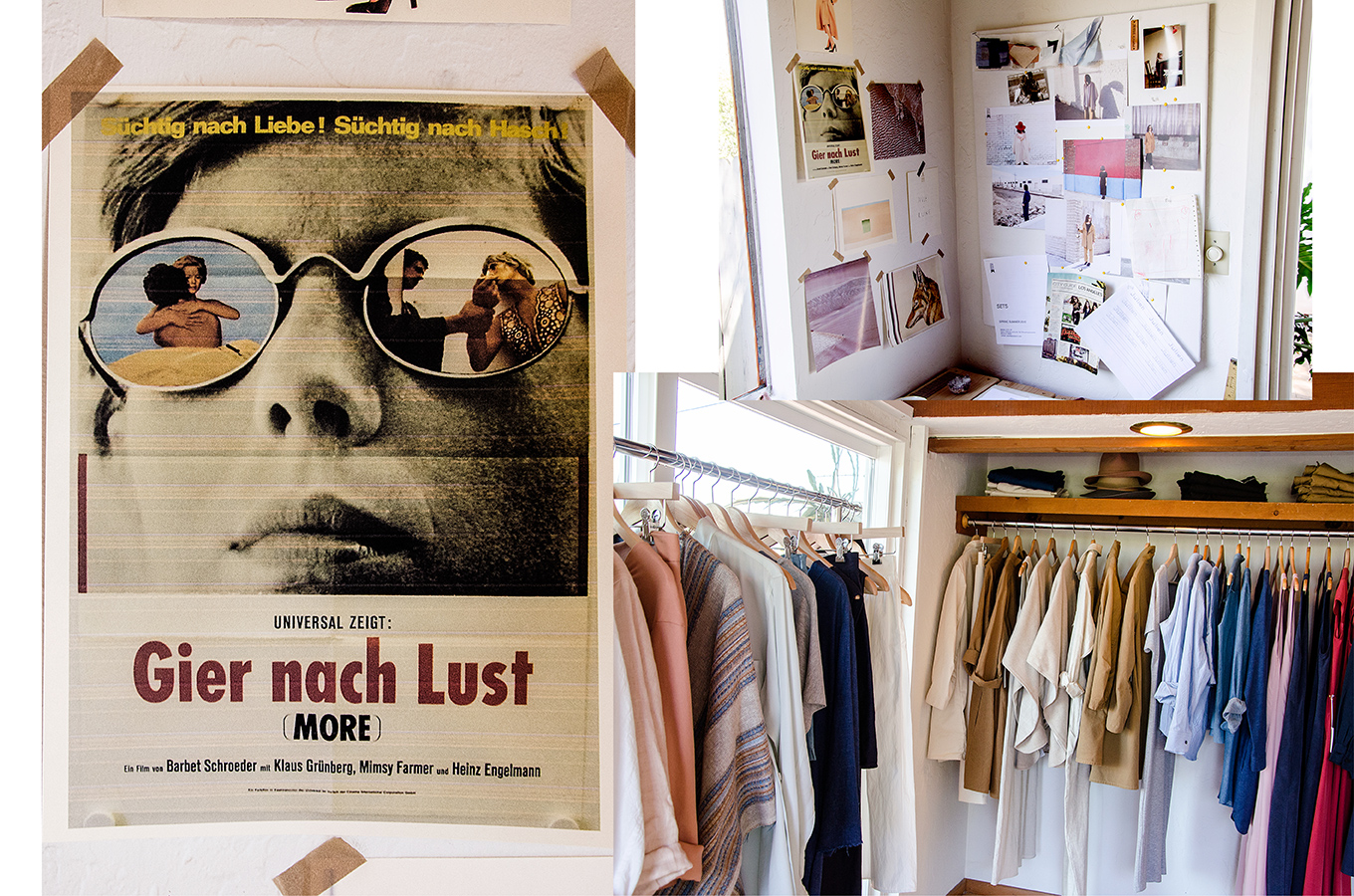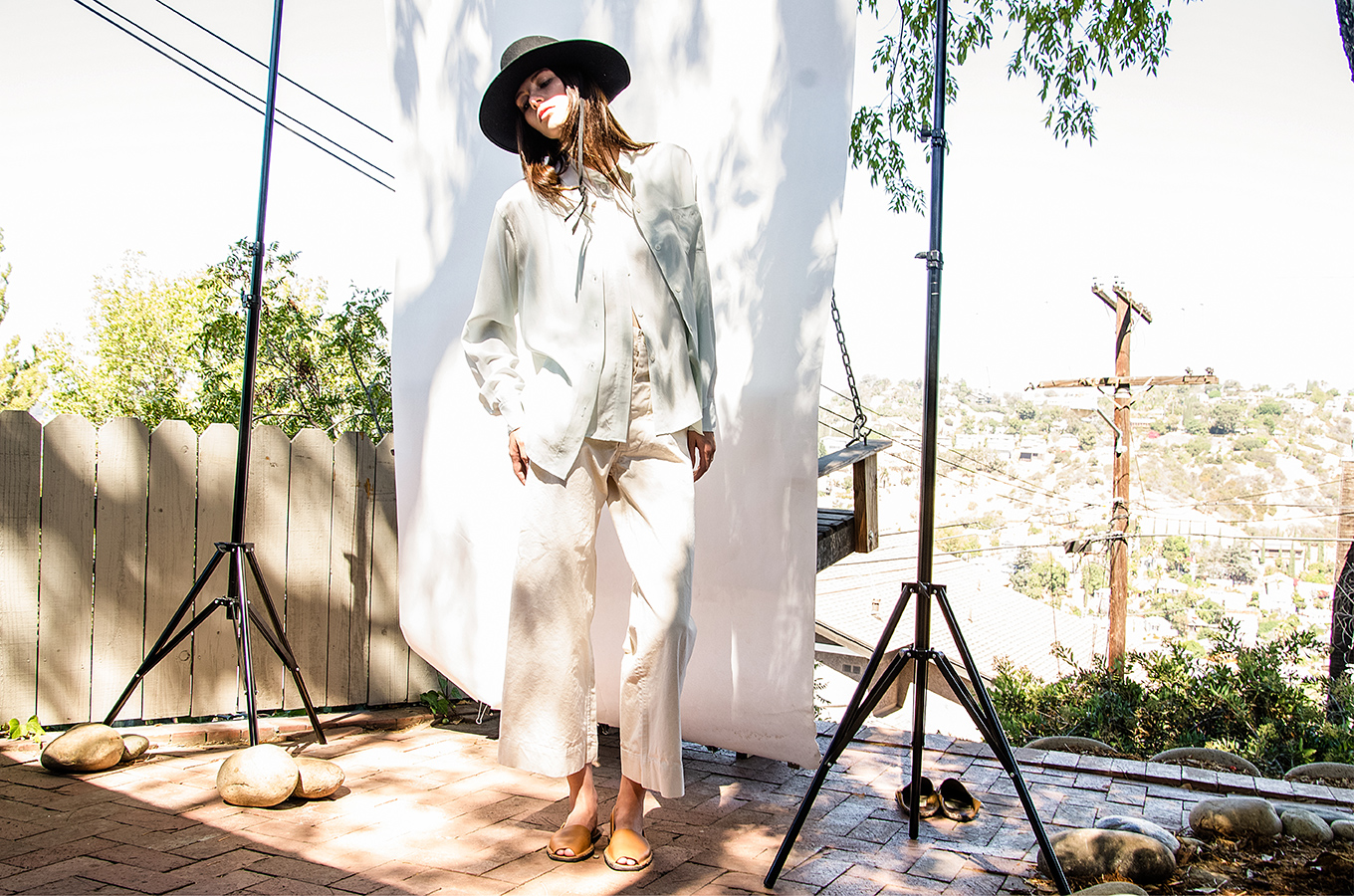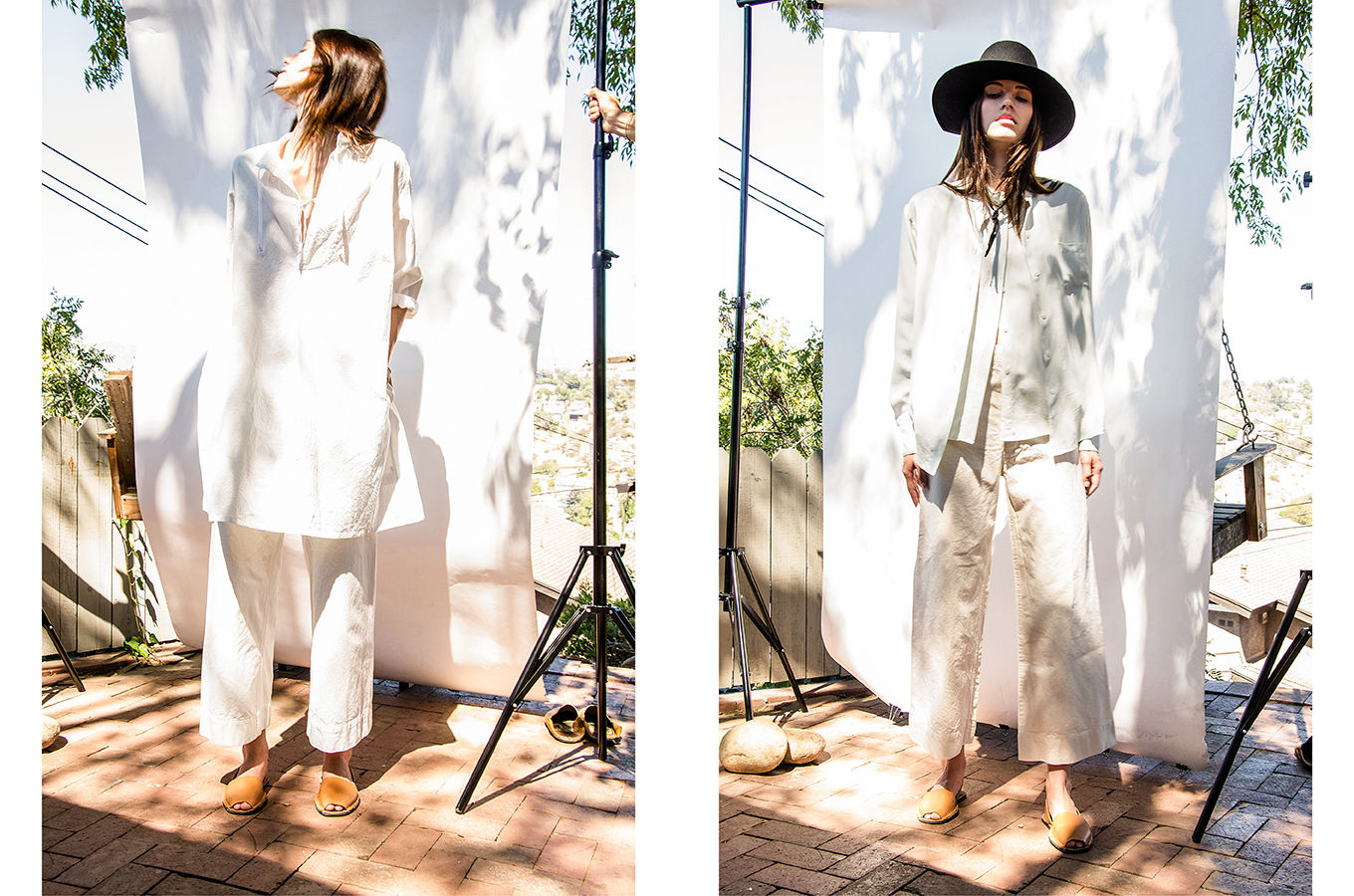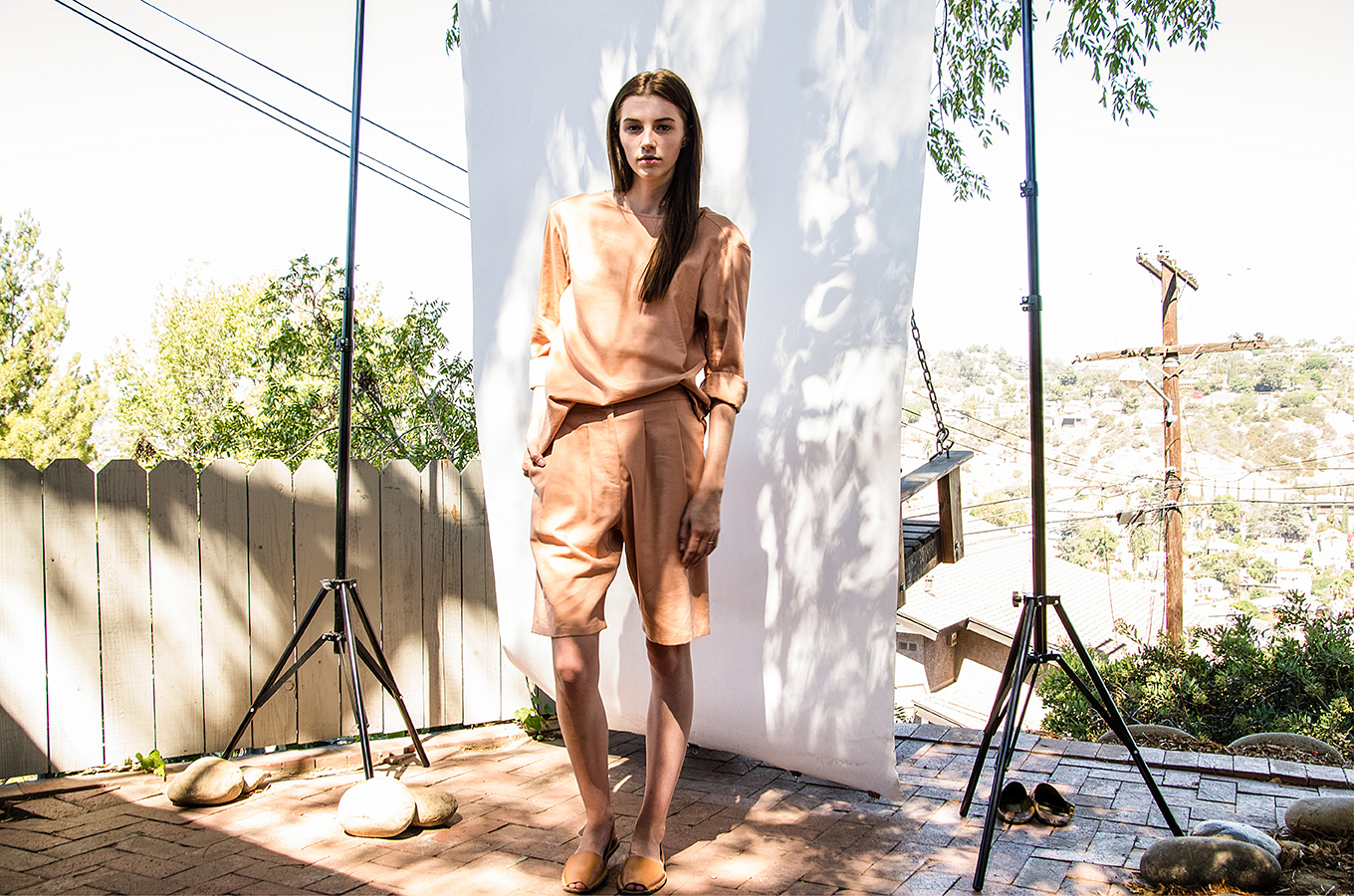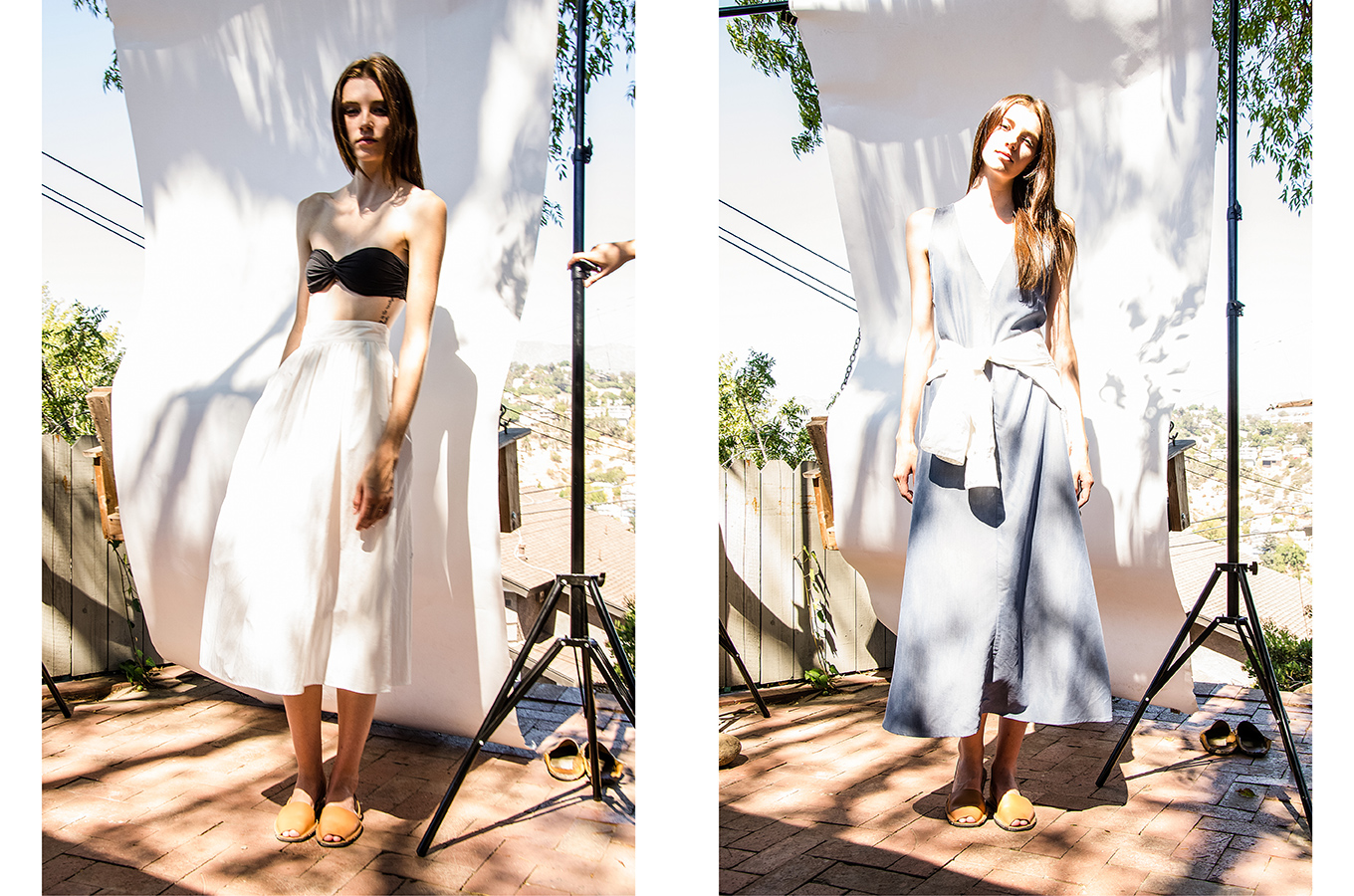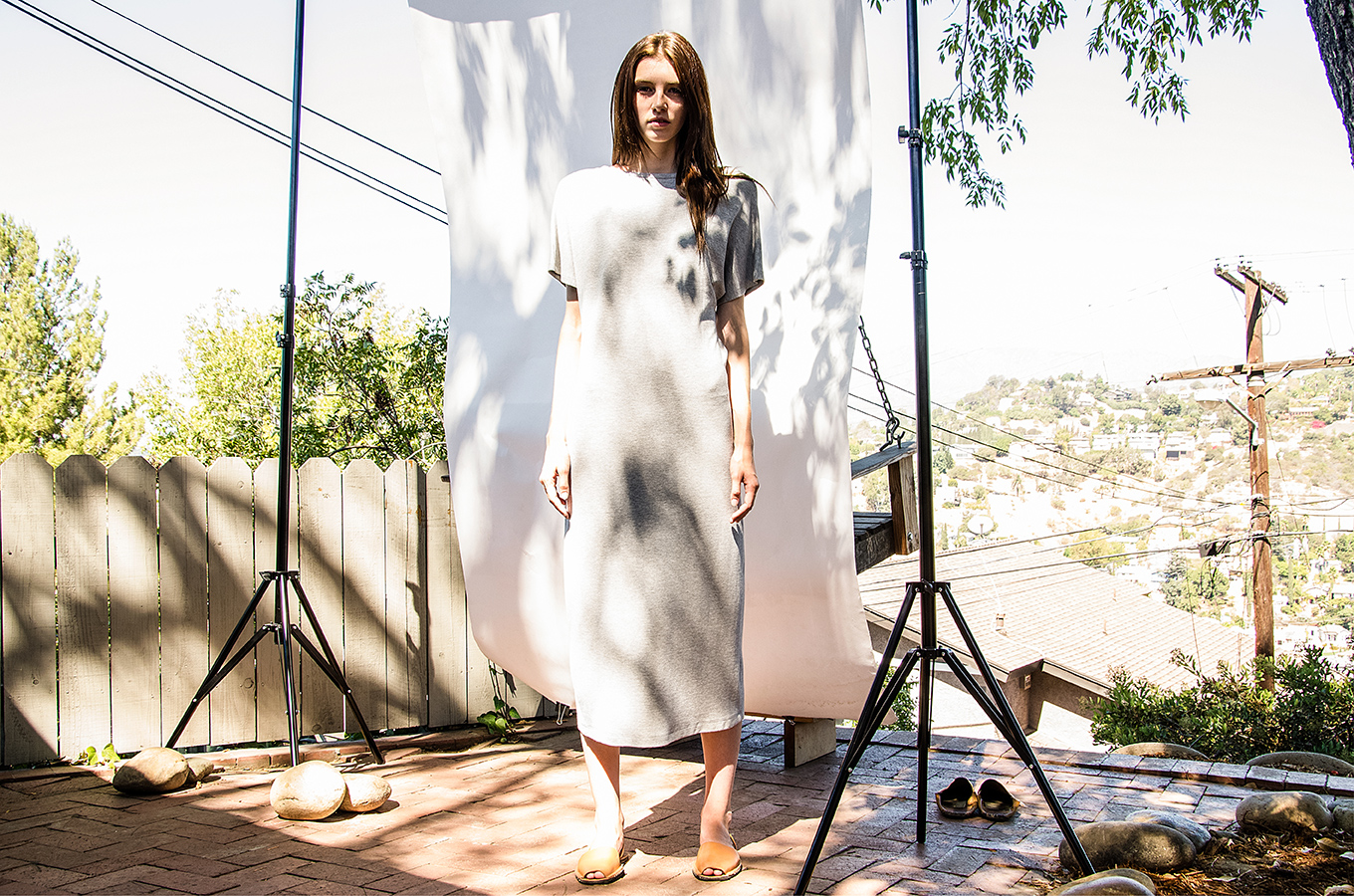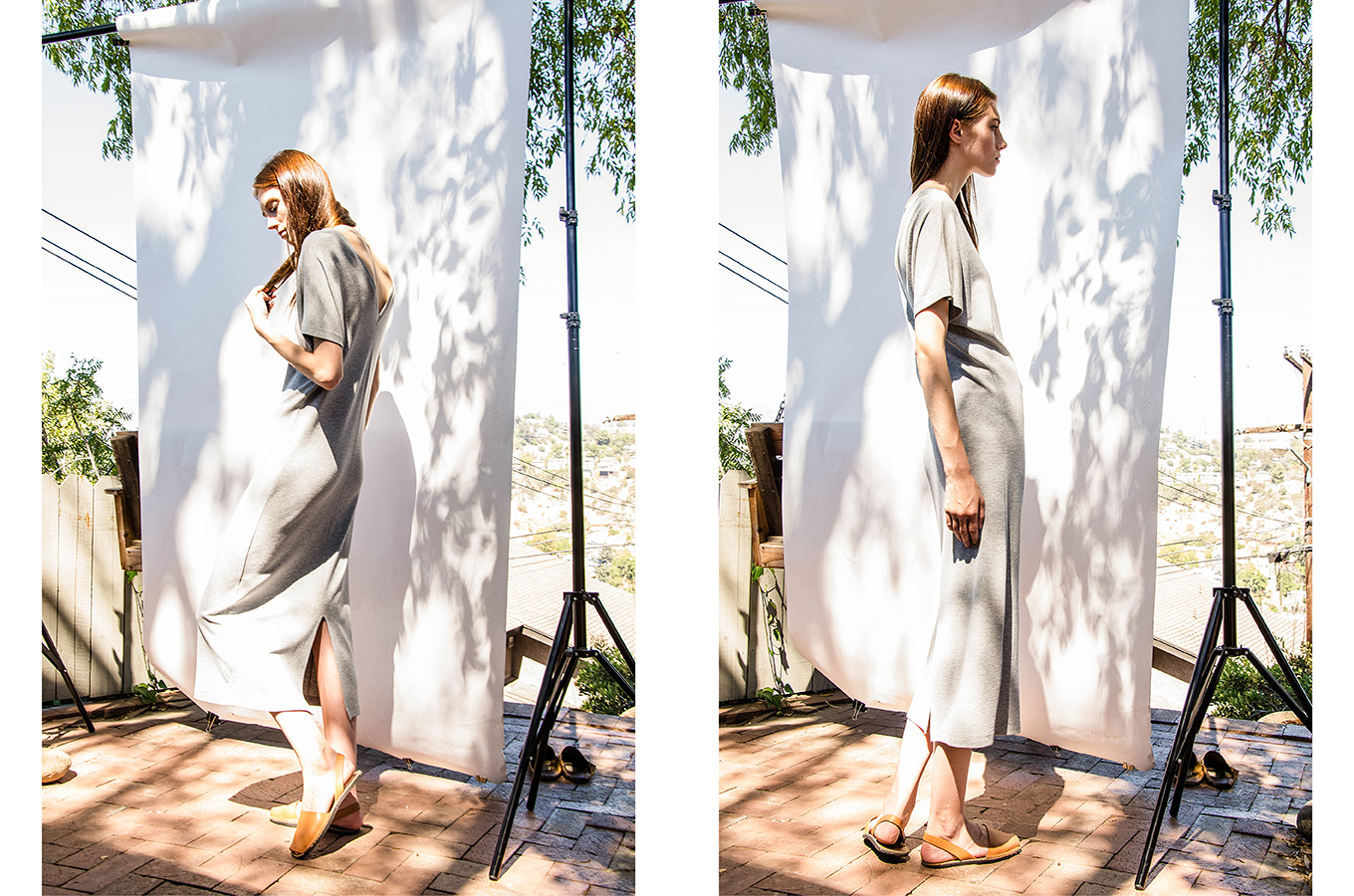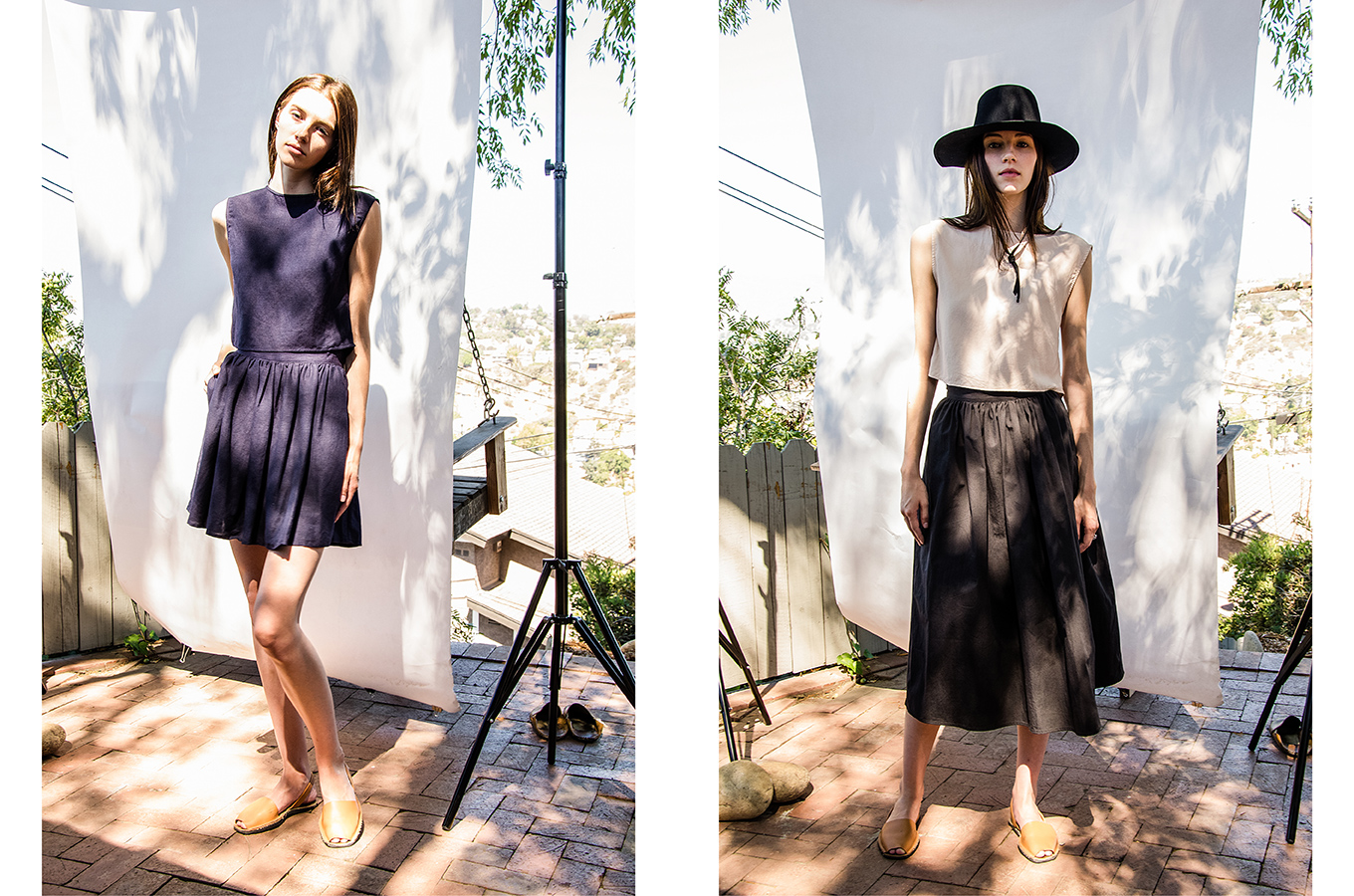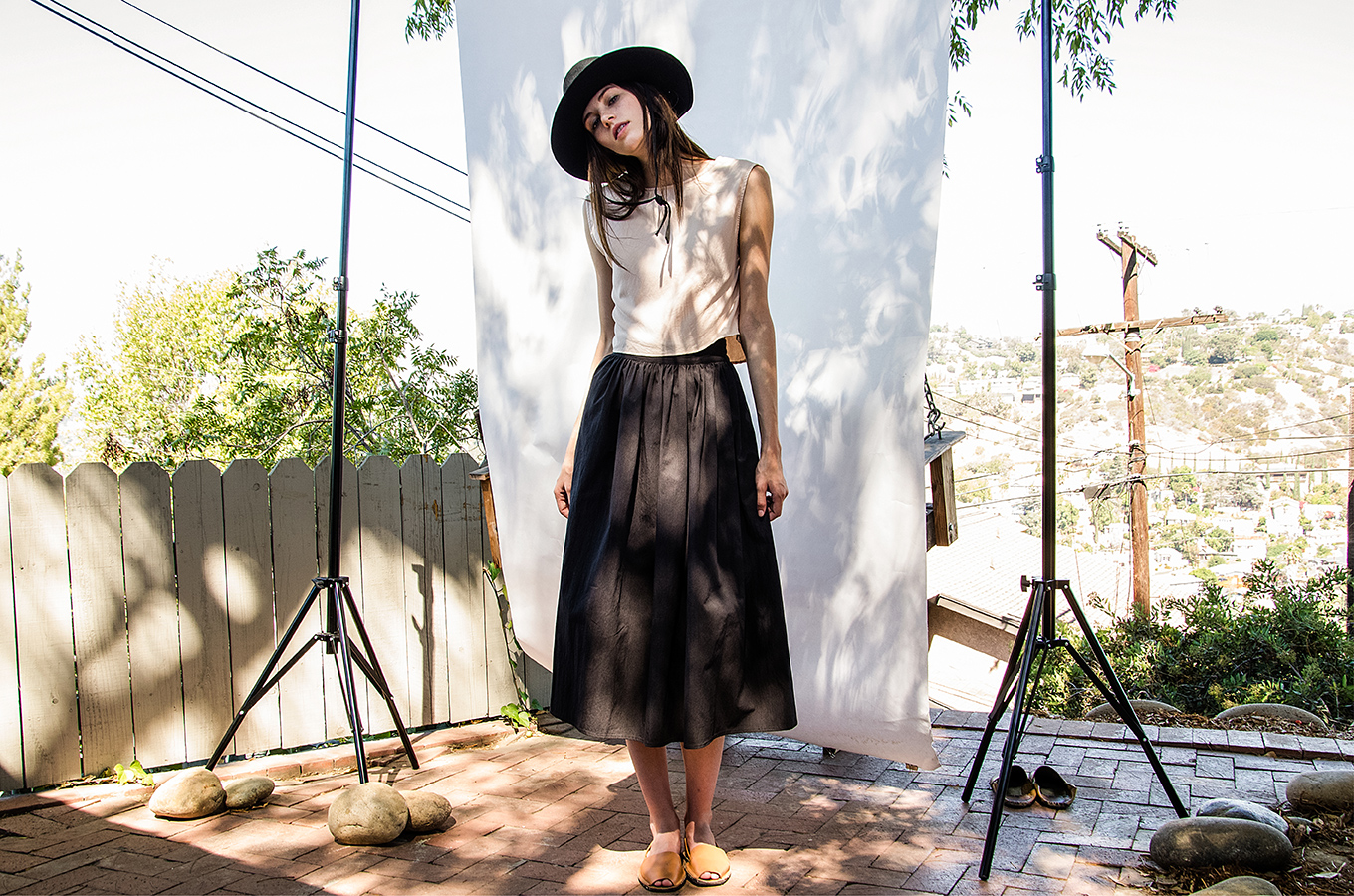Jesse Kamm
Interview by Jessica Makinson
Images by Jan-Willem Dikkers
Editor: Ariel Gearhart
“I am a lone wolf. It’s just me. So I’ve decided that this is my 'jobby.'
It’s part job part hobby, and it really allows me
—Jesse Kammto have a lot of fun and freedom in the work that I do.” — Jesse Kamm
Jesse Kamm
Born in Illinois, Jessica Fern Kamm is a Los Angeles-based designer. Her luxury, artisan clothing label, Jesse Kamm, is a collection distinctive for its minimal design, clean lines, and classic shapes. Dedicated to sustainability, Kamm reduces her label’s environmental impact by using recycled and repurposed products and non-toxic inks. She is also a cofounder of Punta Carenero, an off-the-grid sustainable community in Bocas del Toro, Panama, where she spends three months of the year with her husband and son, living in their self-built house and surfing. You can find her collection here.
At the top of a quiet LA mountain, after the winding steep streets and amongst the urban wilderness, Jesse Kamm welcomes us into her home studio tucked away in the back of her house. Sliding glass doors open to her personal view of the city, with her son’s playthings near the base of his tree house. Rocks collected from her adventures are lined up on the floor inside, underneath racks of clothes, and trinkets cover the desk. Her current collection, hung in a color coordinated fashion, tells the story of her annual summers in Central America. Her creativity is fueled by simplicity, travel, and family.
Dressed from head to toe in the tones of the desert, Jesse sat down with us to explain her philosophies of life, her “jobby”, and her effortless style. The ease with which she handles both her design and lifestyle, and the way she weaves them together, is inspiring. Her eyes light up just talking about it.

Jessica Makinson: It’s great to see your collection in person, to look at the texture and see it all together.
Jesse Kamm: I think something that’s very true about my collection is there are big boxy shapes, so when you look at them on the rack you’re kind of like, “Hmm… that looks pretty boring.” But I think the beauty of this collection comes with putting the pieces on and feeling the fabric and noticing the simplicity behind the shapes and how they fit a woman’s body. I think that having them on a person is paramount to really letting the pieces shine.
I had been in Panama all summer and I had the bulk of the collection finished before I left, so I had the shapes and a lot of the colors, and worked to put the finishing touches on and round the whole collection out. I started collecting these rock sets that sort of determined where all of the colors of the collection came from.
JM: Absolutely. The fabric you use, where do you source it from?
JK: A couple different places. I feel like my collection has grown in terms of quality immensely over the last five years after my son was born. I was trying to simplify my collection because prior to my son everything was hand printed. It was all these hand printed textiles and patterns, and that was what the whole thing was about. I would hand draw all this stuff and then I would hand print it on fabric, and it was all these silks because you needed this certain texture to take these prints. And then he was born and I was literally like, “I cannot do that anymore.“
Luke [my husband] and I just used to roll out bolts of fabric and print in this giant apartment we had in West Hollywood. I was like, okay I’ve got to pull away from that and my friend Maryam actually was talking to me about the collection one day and she was like “What if you just let go of the print?” And I was like, “But that’s my thing,” and she was like, “Actually, you have a really good understanding of color and texture and what if you just tried to allow yourself to focus on that?” It was honestly the most freeing statement someone ever gave me because I didn’t allow myself to think outside of the print and as soon as I did I got really into these textures and this like crinkled crushed fabric that is sort of my ode to the eighties.
“The beauty of this
collection comes with
putting the pieces on, feeling
the fabric and noticing the simplicity
behind the shapes and how they
fit a woman’s body.”
— Jesse Kamm
I worked super hard with a fabricator downtown to create my own version of that, and you can see it in a couple of pieces here. And then I started sourcing these Japanese textiles that had that built into them. Then came this windfall of beautiful Japanese technical fabrics, which I started looking into because I was looking for more environmentally conscious fabrics. That whole conversation is a very slippery slope because something’s organic, but the moment you dye it in bulk in India, the dye gets dumped into the river. Getting into the whole eco-conversation is not a place I really even want to go, with talking about manufacturing, because it’s the kind of thing where I’m a very conscientious person and we are a very conscientious family.
All of that plays into everything that I do in terms of small production, choosing the fabrics that I can best attain with my dollars, and my knowledge of what’s out there. I’m not going to choose only a certain kind of fabric that’s going to narrow me into this hole, but I make the best choice every step of the way. I didn’t set out to be an eco brand but, you know, we drive a car that runs on vegetable oil, we have a solar powered house that’s not here [in LA] but one day this [house] will be a part of that. We try to grow some of our own food, and just think about our impact every step of the way. That just naturally translates into what I do, but it’s not like a platform I’m on, it’s just the way we are.
JM: That’s definitely along the lines of questions I had about your textiles, saying you use dead stocks. Do you still do that?
JK: I still do that whenever I can, and what’s great about what I do is I sort of have a cap, which is like twenty stores. That’s what I believe I can handle and manage selling to because I am a lone wolf. It’s just me. I’ve tried to bring other people on – I’m too controlling and need to be a part of all of it to allow someone else to do the different things, so I’ve decided that this is my “jobby”. It’s part job part hobby and it really allows me to have a lot of fun and freedom in the work that I do.
I finish everyday at 2:30 or 3, I pick my kid up from school and we chill. We just hang and ride bikes and skateboard and do our thing. I feel like as a priority I have my son and my family, and I have my surf and that’s my church, and I have this work which is very important to me. I do it because it brings me joy and financial income, because a man’s gotta work, but I don’t feel like I am at all a part of the circus. I don’t feel like I’m in “fashion”. I mean I do, but I feel like this is just a craft and it’s been fulfilling me for almost ten years and I love it and I love that other people love it, but I don’t live and die by it.
JM: You definitely do it in your own way.
JK: And always trying to figure out how to work smarter and not harder and to inspire other people to find their way. Because I see a lot of women who have their own businesses or who work for other people and are kind of unhappy in this place and I’m always just saying like, what if you just tweak that a little bit? You haven’t had a vacation in five years, don’t you feel like you’d be more healthy if you changed a couple of things. And people are like, well I don’t think I could. But why? You can. Especially in our modern era of technology where the world is literally flat. Maybe that’s the wrong word to choose.
JM: I think people are hungry for that kind of perspective and that’s also why people gravitate towards your way of life and the way you spend 3 months out of the year in Panama. People are drawn to that.
JK: Well, you know it’s funny – I’ve been working really hard and just got back from New York and feel sort of drug down and not my normal light, bright self. I’ve been home from Central America for six weeks now and I was starting to really miss it and I just thought, “Okay. You guys are coming at 11:30.” I put on my bikini and I laid out there for thirty minutes and it just felt so amazing and I felt really guilty about it and then I was like, “Fuck this, man. I deserve to reset.” Some people have the gym. I can’t get to the gym with my schedule and my child and all this other stuff, but that was completely rejuvenating for me and I got a little sweaty and came in and sent some emails and did all this other stuff.
Then I was like, I need to share with people that this is okay. I finally got to a place where I gave myself permission and then I was like I should give everybody else permission because this feels really good. We are too American when we’re like “Work, work, work!” and only vacation one week a year, I think that’s crazy. I’m really into reverse retirement. It’s something I think we humans need to play. We need to be in nature. We need to move, we need to exercise our bodies.
“I’m really into reverse retirement.
I think we humans need to play.
We need to be in nature.
We need to move,
we need to exercise our bodies.”
— Jesse Kamm
JM: I love that perspective that you’re trying to share. It’s great for people to have an example.
JK: Well, I feel like that’s my real job here: to cheer everybody else on. You deserve that.
JM: Where are you from?
JK: Highland, Illinois. 7,500 people, rural. Rural, rural Illinois. Cornfields, white people, Coors Light.
JM: When did you start designing?
Mark Haddawy
Mark Haddawy specializes in complete renovation and interior design, and is known for his extensive work in historic preservation of California modernist architecture. He is also the co-founder of Resurrection, a vintage boutique located in both NY and LA.
Resurrection
A NY and LA-based vintage boutique specializing in collectible and historic clothing, founded in 1996 by Mark Haddawy and Katy Rodriguez.
JK: 2005. I had been a model. I was a model and it destroyed me and I threw my hands up and said I got to find some other way. Then as soon as I let that go and closed that door, I did not know what I was going to do. I have a university education in something totally unrelated but I knew that I was really into vintage clothes and really into the idea. So I took this six-week sewing class at LACC and I just started making some of my own clothes and a friend of mine who was a stylist said, “Well if you want to learn about fashion you should work for Mark Haddawy at Resurrection. He’s like the living archivalist. He can teach you anything.” And so for ten months I went and worked part-time for him. He taught me everything from how to sew on a button properly to the history of Schiaparelli and Balenciaga and all of these things that I, as a kid from the cornfield, knew literally nothing about.
I grew up with no fashion but my parents were very aesthetic in their work. My dad was an engineer and a draftsman and my mom was a potter, and my dad’s a musician, so we were very minimal sort of hippie – we were very much outside of the box in this rural setting. It was really special and amazing but there was no fashion. We didn’t have money. I didn’t look at magazines. I’m not one of those girls who’s like, “I’ve been looking through the pages of Vogue since I was five!” There was no Vogue. I might have borrowed my friend’s Teen Beat but there was really nothing else. It never even occurred to me that people lived in New York or Los Angeles and did these jobs. I was oblivious.
JM: It’s funny how what you do now came out of that place.
JK: It’s so raw. It’s very earthy. And I see a lot of my childhood and my parents in all of that. And in the way that I live my life, they are my greatest inspirations. My mom is the ultimate, “I will not do something that’s going to make me feel bad.” She’s an incredible potter. She’s had opportunities to have her work around the world and many opportunities to cash in on me talking about her. But she’s just like, “I don’t want that stress, I’m perfectly happy selling it at the farmer’s market. I’m perfectly happy selling this $250 bowl for for $30.” That’s her way and that’s where I get that strong, “I’m not gonna take on that extra load because it’s not gonna make me feel better.” My father is the same way, they are the same as me. We are just simple, minimal, mildly neurotic, very clear on our goals. And that’s that.
JM: I guess that’s when you decided to do this? In 2005?
JK: Yeah, I was making clothes and I was doing these hand drawn images on these cotton voile tank tops. Barney’s wanted to buy this first little collection and I was like, “Each piece takes me six hours by hand.” They wanted me to wholesale them for $65 and I was just like, “I can’t!” And someone said, “Well why don’t you learn to screen print?” So I got into printing fabric and I made my first piece, and I walked over to Ron Herman one morning for a cup of coffee on my way to work. This girl was standing behind me in line and she was like, “Hi. Where did you get that amazing dress?” “I made it,” and she was like, “Can I buy one?” And I said, “Yes, $500,” and she said “Okay. How soon? I have a party on Friday.”
Sarah at Colette
Sarah Andelman is founder and creative director of Colette, a Parisian concept store world-famous for its tightly curated mix of high-end and street fashion, up-and-coming designers, and offbeat lifestyle products.
So I made it and it went like this: within three weeks Elle Magazine had a crew of people in my studio sharing a story about my collection, which had four pieces in it. At the time, one of a kind, but then I just figured out how to reproduce them. They were all these shapes that I just made the patterns myself and they were really simple. There was a triangle, and there was a rectangle with arms. Then I saw an opportunity and I made a little look book. This stylist Patrick Milani was going to Europe and he said, “I’ll take it to Sarah at Colette,” and three weeks later she placed my first order.
“Within three weeks,
Elle Magazine had a crew
of people in my studio
sharing a story about my
collection, which had
four pieces in it.”
— Jesse Kamm
I remember I called my dad, and my parents were so not into me being a model. They thought that that was a horrible thing for me to do with my talent and my creativity and my education. And it was, but I had to do that to figure out that it wasn’t right for me. And I called him and I said, “Dad! This thing is happening! It’s just crazy, it’s just flowing!” He said, “Hey, that’s how you know you’re doing the right thing, that’s how you know you are doing what you’re supposed to do.”
I really knew nothing at the time and I worked about sixteen hours a day for about two years learning every aspect of the business. And coming from the standpoint of being the model where someone else was in charge of how I dressed, how I wore my hair, where I went, how much I was supposed to weigh, what I cold eat – I got these emails from every showroom in New York, every press agency saying “I wanna rep you,” I just said, “No, I wanna do it myself.” I wanted to understand what it meant to handle press or to handle sales and I just didn’t want it to get out of my control.
From that point, back to Mark Haddawy, the best advice I was ever given was to grow organically. Somebody wanted to give me an investment in the beginning and he was like “What are you going to do with $15,000?” and I was like, “I can buy a new computer or I can do this.” And he said, “You can do that on your own in four months, don’t do that.” So I would sell like six dresses, then I would make more fabric, then I would have twelve dresses and I’d sell those. Within a year I had paid off my student loans, I sent my parents on a trip to Hawaii, I bought myself my Mercedes Benz which I hope I’ll drive till I’m ninety years old.
And before the boy, before that child I made, I did work a lot harder – in terms of that grind and the willingness to take on things that might have been too much for my sensitive constitution. I took on a lot, but having him changed my whole perspective on what matters, of course. And I can thank him for really becoming this person who wants to let everybody know we can make our own way.
JM: Did he change the way you dress or the way you design?
JK: Absolutely! Everything got way more chic. It got way more mature and chic. And simple. Those things really work with who I am and they happen to work with a lot of other people as well and so it did very well for my sales. The whole simplification of the print and opening my mind. I mean, when I wasn’t dealing with all that other stuff I really had a lot more time to say, ”What do I want to wear? What feels really good? What shape do I want to wear today?” I would just get to spend hours in my closet putting things on and figuring out what’s missing. If I could wear anything right now, what would it be? And trying to figure out if I made that, would it translate? Because sometimes I make things that are just for me that I know won’t sell, but often times I have to choose something that I feel will relate to the public, so that I’m not wasting all this money building samples. It’s very expensive. Especially making things here in California, it’s costly. I have everything I need in my world but I’m also very concise with my pocketbook. I’m not interested in just throwing caution to the wind. I’m very calculated in all manners.
JM: Is everything you make something you would wear yourself?
JK: Well that’s the glory because I’m the sample, so I get one of everything. And I really don’t do any shopping. I do not shop for women’s clothes, I only wear these pieces that I make. Maybe I will get a little vintage thing here or there, and I do give myself a budget for shoes. You gotta have shoes and I don’t make shoes.
JM: Any fantasy collaborations to make shoes or anything else?
JK: I mean honestly, I’m going to go ahead and say it: collaborations are a pain in the rear and nobody makes any money as far as I can tell. I love doing them, but it’s gotta be for pure joy or something that’s going to bring you great interest from the people that write text about you, because it’s not a monetary benefit. If somebody asked me to design a shoe, hell yeah I would do that. I think they’re beautiful. This is one of those things –I don’t need to make shoes with somebody else because so many people make beautiful shoes. I’m just perfectly content making this one little thing. And if I need a sultry dress for a night out, I’m totally happy to go get a vintage Dolce & Gabbana or something like that. I don’t need to fill all the holes; I’m perfectly content with my tiny little niche.
JM: You came out of LA, studied here, and got serious about designing here, so how do you feel about the rising creative scene in LA?
JK: I mean I am so happy that people are getting creative. It really doesn’t affect me because I just live on this tiny little bubble on this tiny little mountain. I don’t get to participate in it the way that I’d imagine I would have before I had a family. It’s really lame to say that but it’s the honest truth. I work up until the minute he goes to bed and I really don’t have any energy to do anything, it’s so sad. I mean, it’s not sad because I don’t lament it, but I had a very amazing social life for much of my life.
It thrills me to no end that people are coming here because they find it to be inspiring. I’ve always found it to be inspiring and I’m terrified of what’s going to happen to the traffic! I was just in New York and everybody’s like, “I wanna move to LA,” and I’m just like “Fuck! The 2 freeway is just going to be crammed! How am I gonna get downtown because I really can’t deal with the traffic!” I love it when I do have time to get on the train and go downtown and have a lovely night out at these openings at the stunning shops with these stunning people who are making beautiful things. It’s wonderful. And people plunk me in with that because I’m here, and I’m honored.
JM: What kind of music do you listen to?
Jimmy Cliff
A Jamaican reggae musician, multi-instrumentalist, singer, and actor. He was granted the “Order of Merit” by the Jamaican government for his work in the arts, and was inducted into the Rock and Roll Hall of Fame in 2010.
JK: I don’t know can you please recommend something! I got nothing, man. I’ve got this Spotify station that’s based on some old Jimmy Cliff records that has been spinning here for like two years straight. If everybody that came into the house gave me just ten songs to listen to, I would just be a whole new woman. I need some help, I really need some help.
“It thrills me to no
end that people are coming
[to LA] because they find
it to be inspiring. I’ve always
found it to be inspiring.”
— Jesse Kamm
JM: Have you ever let go of a piece that you can’t forget about? Either gave away or lost it, or just not purchased something vintage?
JK: There was this beautiful pair of pumps. Black suede and they were in the most perfect shape and I got them at Resurrection and I wore them to death. It’s the kind of thing that I then gave to Goodwill or somewhere, and I wish that I had kept them so someone could’ve remade them. They were like two and a half inches but looked really sexy and, I mean, I’m six feet tall so I don’t need to be teetering around on a four-foot heel. But it was a perfect shape.
JM: What film do you wish you could live inside of because of the costuming, era, or inventiveness?
JK: My friend Hilary Walsh – who is a stunning photographer – about a year ago I was feeling like I really had been in my bubble too long and I was like, I need a movie or some music or something, just send me something. She sends me this word,”More.” They’re in Greece or Capri or something in the late sixties and it’s bananas. It’s in the beginning of sexual freedom and drugs. There was a lot of drug use but the sea and the adobe sort of O’Keefe style house on this cliff and it just looks like, in my next life, that’s where I’d exist.
JM: What question do you wish I would ask you?
JK: “Can you really surf?”
JM: Can you really surf?
JK: Yes, I can. Very well. I started surfing ten years ago and I’ve progressively gotten more and more into it. And this summer I got that thing – the thing people always warned me about when I was starting to date a surfer – which is don’t date a surfer, they’re addicted. There’s this addiction and you got to be really careful and this summer I was infected with this addiction. It is a real thing. I kept a journal this summer everyday when I got out of the water because we got to surf crazy amounts. I got to surf four-and-a-half hours a day for sixty days in a row. So my ability catapulted just because – there is this theory Malcolm Gladwell has about how many hours –I got like 175 hours in this summer. But when you do something enough you get better.
We like to go to Huntington Beach, it’s about an hour. I’ve enjoyed surfing in California more than ever before since I’ve gotten home from Panama, but there’s nothing like our house on the sea and the waves right there and you just have some coffee and an egg and you go. You can come home and say, “High five! Now you can go! Or the babysitter’s here we can both go!” It is very dreamy.
I have a friend who lives across the street and she is a very successful business woman and my son was starting school and there was this night with this PTA shit and I couldn’t make it because this hurricane came in – I wanted to catch the end of it and I felt really guilty because I went and did this thing for myself. And she was like, “Jesse, are you doing your best?” and I said, “Yes,” and she said, “Do you need the surfing?” I was like, “It’s my church.”
